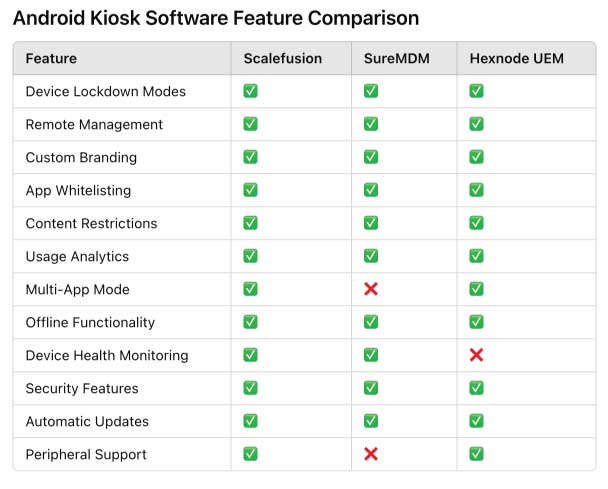Android Kiosk Software allows organizations to transform Android devices into dedicated-purpose kiosks for a wide range of applications, such as point-of-sale (POS) systems, self-service terminals, and digital signage. These tools provide administrators with centralized control over devices, ensuring they are secure, functional, and easy to manage. Popular solutions in this category include Scalefusion, SureMDM, and Hexnode UEM. Related software categories include Mobile Device Management (MDM), Digital Signage Software, and POS Software, which share overlapping functionalities like remote control and security features.

Listed below are several examples of software products used in the Android Kiosk Software category.
The table below compares key features of three popular Android Kiosk Software solutions. This feature comparison highlights the capabilities of each product, making it easier to determine the best fit for your needs.

The feature comparison table reveals that all three Android Kiosk Software solutions—Scalefusion, SureMDM, and Hexnode UEM—excel in core functionalities like device lockdown modes, remote management, and custom branding, making them strong contenders for secure and customizable kiosk management.
However, differences emerge in more advanced features: Hexnode UEM lacks device health monitoring, while SureMDM does not support multi-app mode or peripheral integration. Scalefusion stands out as the most comprehensive solution, offering all listed features, making it ideal for organizations with diverse needs and complex deployments.
These variations highlight the importance of aligning software capabilities with specific business requirements when choosing an Android Kiosk Software solution.
Looking to turn your Android devices into secure, dedicated-purpose kiosks? This video demonstrates how to use SureLock by 42Gears to lock down Android phones for single or multi-app mode. Learn how to customize device settings, enforce security, and ensure a seamless user experience—all with just a few clicks. Perfect for retail, education, or any business needing controlled device environments!
The image below showcases a professional Android Kiosk Software dashboard designed for managing multiple connected devices. On the left, a list of registered Android devices provides quick navigation, while the center highlights a detailed map of device locations. The right panel displays essential information about a selected device, including status, battery level, and active apps. Key controls like remote locking, app whitelisting, and updates are accessible through colorful, intuitive icons, making the interface both visually appealing and easy to navigate. The clean, minimalist layout reflects the software’s focus on efficiency and user-friendliness.

Android Kiosk Software is designed to simplify device management while providing a secure and customizable user experience. It allows businesses to configure Android devices for specific purposes, restrict unauthorized usage, and monitor device performance remotely. Below is a detailed look into the essential features that make these solutions highly effective for kiosk management.
Industries like retail, healthcare, hospitality, and education use kiosk software for POS systems, check-in stations, and interactive displays.
Yes, many solutions offer offline functionality and sync data once connectivity is restored.
Yes, most software includes an option to exit kiosk mode using administrator credentials.
It restricts unauthorized access, enforces encryption, and limits apps or websites to prevent tampering or misuse.
Yes, administrators can push remote updates to ensure all devices are running the latest software.
Most Android Kiosk Software allows administrators to schedule or remotely push Android OS updates and patches to devices. Some solutions also enable deferring updates to ensure compatibility with kiosk applications before deployment.
Yes, advanced kiosk software can disable hardware buttons (e.g., power, volume, and home buttons) and block access to system settings through APIs or custom configurations. This prevents users from exiting kiosk mode or tampering with device functionality.
Security is enforced using techniques like encryption, secure boot processes, remote wipe capabilities, and locking devices to whitelisted apps or URLs. Some software also integrates with Android Enterprise APIs to enhance data protection and compliance.